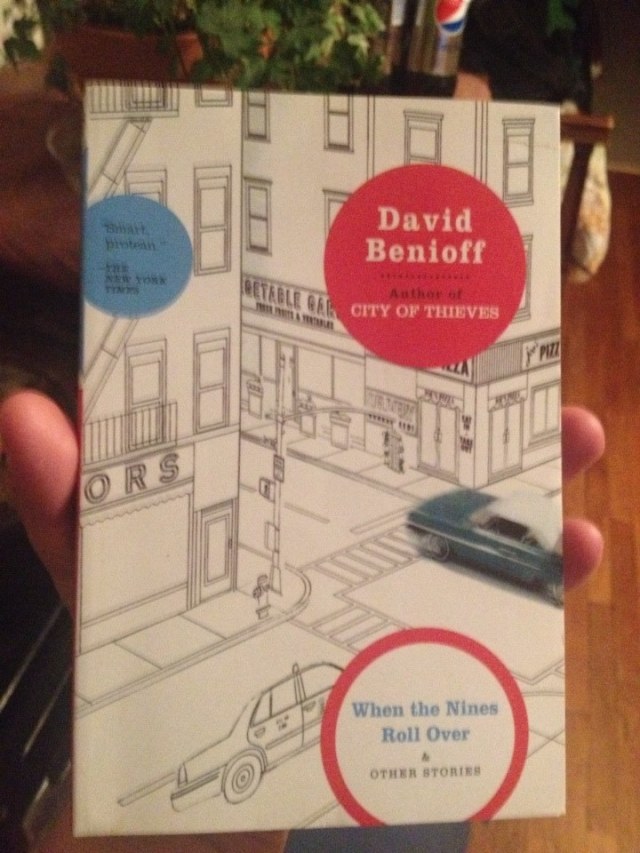Okay, maybe the most Missouri story of all in my four years here: Today, my family and I were down by Lake Springfield, walking a little trail that we like to walk. It’s probably a half mile long at most, but the last/first leg (it’s loop, so it depends which direction you start) is a little rocky staircase that rises along some bluffs along the lake. At the top of these natural stairs is a little cliff you can look out over, viewing Lake Springfield and the surrounding woods. It’s the best view in Springfield, I think, and if you’re ever in town and like to hike and look at pretty sights, hey, there you go.
But anyway, we headed up the non-bluff side today and about a hundred yards up the trail, we heard, “Pop! Pop! Pop!” Gunfire. We saw a dude, maybe 50, and a young girl, around 11, both in full camouflage, firing guns. “What the fuck?” I said and the guy turned around, looked at me, pointed his gun down. “Come on up,” he said. “It’s okay. They’re only BB guns.” Cautiously, my family and I walked past, eyeing the tiny pink targets that had be attached to trees, bushes, and stumps on either side of the path (I checked: It didn’t seem as if they’d hit anything yet). “Just teaching her how to shoot,” the guy said as we went by. Fifty yards later, around several bends, we heard it again: “Pop! Pop! Pop!” I shudder to think what would have happened if we’d come around the other way, down the trail, in their line of fire.
Neither Karen or I commented until we got to the cliff, where Karen said to our oldest son: “You know what’s a good safety tip? Don’t set up a shooting range on a crowded public trail on a Saturday afternoon.”
If you’ve not been to Missouri, folks, there you have it: Majestic scenery, friendly people, and guns. Missouri.
And that has nothing to do with today’s story, “A Doll’s Tale,” thought it’s probably longer than “A Doll’s Tale,” or close to it. “A Doll’s Tale” is kind of a short, kind of a short story, and kind of a fairy tale, and is by Kate Bernheimer, from her collection Horse, Flower, Bird from Coffee House. Bernheimer is the second writer I’m covering from the University of Arizona MFA faculty after looking it up a couple of weeks ago for a friend, finding there were three writers I hadn’t read before on their staff, and ordering their books for this blog (Manuel Muñoz was first on April 18). Not sure what that has to do with anything, either, but hey, maybe that’s the theme for tonight. Sorry, Kate Bernheimer, for tangents.
A bit about Horse, Flower, Bird before I focus on today’s story. All of the stories in this book are short, but take up a lot of pages. Little snippets or paragraph or vignettes—whatever you want to call them—take up sometimes a line or two of a page and that’s it; instead of just putting a space break in between, Bernheimer chose to Insert->Break->Page every time, and Coffee House went along with it. So, “A Doll’s Tale” is twelve pages long, but it’s probably seven hundred words, if that. I read five stories from the book, got to page 120, and that only took about twenty minutes.
Like “A Doll’s Tale,” all the stories in Horse, Flower, Bird are tales, end in the word “Tale,” “A Cuckoo Tale,” “A Tulip’s Tale,” etc., and this, combined with the way they’re paginated, points to Bernheimer writing something akin to fairy tales; the language indicates this as well, fable-buildingesque, almost as if every one started with “Once Upon a Time …” (though none actually do). If not for the dark and adult themes throughout—Jews and ovens run parallel to each other, e.g., in each of the first three stories—I would have thought I’d accidentally bought a book for children (which Bernheimer also writes, though her website clearly place Horse, Flower, Bird on the non-children’s page). There’s even drawings on a title page for every piece.
Peter Buck blurbs it, for some reason.
“A Doll’s Tale,” by the way, is about a girl named Astrid who is tight with her sister, tight like they have matching twin beds in their bedroom and hang sheets over the middle to make forts. Yeah, that tight. But then Astrid’s sister is grown up and gets married, and Astrid is alone. To compensate, Astrid’s parents buy her an Astrid-sized doll to keep her company (…), which Astrid loves and names Astrid. Then, at one point, she tires of it and fake-loses it forever. She acts devastated, and might be, but then again, she lost it on purpose, and is seen smirking when her mother calls the hotel where it was lost and comes up empty. Astrid, as you can see, is the final exam at the clinical psych school at the Freud Institute.
The pattern repeats itself, first with an imaginary friend named, you guessed it, Astrid, and then again. And then, well, it’s only like seven hundred words, remember? You’ll have to find out for yourself how this fairy tale ends.
Really, this post is more about Kate Bernheimer’s book, Horse, Flower, Bird—which I enjoyed for being something completely different … and challenging—than it is about any one story. It’s cool, I think, that this book exists, that the Coffee House people saw this accumulation of little contemporary fairy tale stories, and and agreed to make and distribute it as a book, a book that might be less than ten thousand words long (I should talk: Chicago Stories is barely eight thousand). It does exist, which is great, and I’ve read most of it. Might as well knock this one off all the way.










